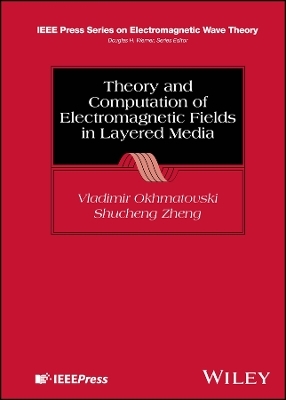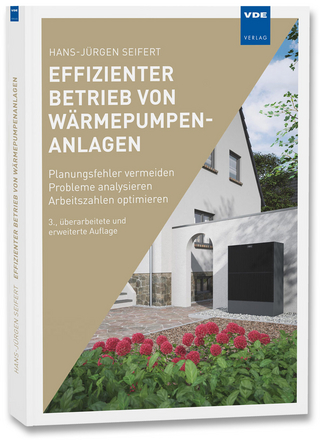
Theory and Computation of Electromagnetic Fields in Layered Media
Wiley-IEEE Press (Verlag)
978-1-119-76319-2 (ISBN)
In Theory and Computation of Electromagnetic Fields in Layered Media, two distinguished electrical engineering researchers deliver a detailed and up-to-date overview of the theory and numerical methods used to determine electromagnetic fields in layered media. The book begins with an introduction to Maxwell’s equations, the fundamentals of electromagnetic theory, and concepts and definitions relating to Green’s function. It then moves on to solve canonical problems in vertical and horizontal dipole radiation, describe Method of Moments schemes, discuss integral equations governing electromagnetic fields, and explains the Michalski-Zheng theory of mixed-potential Green’s function representation in multi-layered media.
Chapters on the evaluation of Sommerfeld integrals, procedures for far field evaluation, and the theory and application of hierarchical matrices are also included, along with:
A thorough introduction to free-space Green’s functions, including the delta-function model for point charge and dipole current
Comprehensive explorations of the traditional form of layered medium Green’s function in three dimensions
Practical discussions of electro-quasi-static and magneto-quasi-static fields in layered media, including electrostatic fields in two and three dimensions
In-depth examinations of the rational function fitting method, including direct spectra fitting with VECTFIT algorithms
Perfect for scholars and students of electromagnetic analysis in layered media, Theory and Computation of Electromagnetic Fields in Layered Media will also earn a place in the libraries of CAD industry engineers and software developers working in the area of computational electromagnetics.
VLADIMIR OKHMATOVSKI, PHD, is a Professor in the Department of Electrical and Computer Engineering at the University of Manitoba in Canada. His research is focused on fast algorithms of electromagnetics, high-performance computing, modeling of interconnects, and inverse problems. SHUCHENG ZHENG is a Postdoctoral Fellow in the Department of Electrical and Computer Engineering at the University of Manitoba. His current research interests include computational electromagnetics, multi-layered media Green’s functions, high-performance computing, the modeling of high-speed interconnects, and transient analysis of power systems.
About the Authors xvii
Foreword xix
Preface xxi
Acknowledgments xxiii
Acronyms xxv
Introduction xxvii
1 Foundations of Electromagnetic Theory 1
1.1 Maxwell Equations 2
1.2 Curl–Curl Equations for the Electric and Magnetic Fields 6
1.3 Boundary Conditions 7
1.4 Poynting Theorem 11
1.5 Vector and Scalar Potentials 15
1.6 Quasi-Electrostatics. Scalar Potential. Capacitance 19
1.7 Quasi-Magnetostatics 21
1.8 Theory of DC and AC Circuits as a Limiting form of Maxwell Equations 31
1.9 Conclusions 35
2 Green’s Functions in Free Space 37
2.1 1D Green’s Function 37
2.2 3D Green’s Function Expansion in Cartesian Coordinates 41
2.3 3D Green’s Function in Cylindrical Coordinates 44
2.4 Physical Interpretation of Conical Waves Forming Sommerfeld Identity 46
2.5 Integral Field Representation Using Green’s Function 50
2.6 Field Decomposition into TE- and TM-waves in Cartesian Coordinates 51
2.7 Free-space Dyadic Green’s Functions of Electric and Magnetic Fields 54
2.8 Conclusions 59
3 Equivalence Principle and Integral Equations in Layered Media 61
3.1 Quasi-Electrostatics Reciprocity Relations in Layered Media 62
3.2 Equivalence Principle for the External Electrostatic Field in Layered Media 63
3.3 Integral Equation of Electrostatics for Metal Object in Layered Media 68
3.4 Integral Equation of Electrostatics for Disjoint Metal and Dielectric Objects in Layered Media 70
3.5 Integral Equation of Electrostatics for Metal and Dielectric Objects Sharing a Common Boundary and Situated in Layered Media 74
3.6 Integral Equation of Electrostatics for Dielectric Objects Sharing a Common Boundary and Situated in Layered Media 77
3.7 Integral Equations of Quasi-Magnetostatics for Wires in Layered Media 81
3.8 Full-Wave Reciprocity Relations in Layered Media 85
3.9 Integral Representations of Electromagnetic Fields via Equivalence Principle 91
3.10 Electric Field Integral Equation (EFIE) for PEC Object in Layered Medium 105
3.11 Magnetic Field Integral Equation (MFIE) for PEC Object 106
3.12 Coupled EFIEs for Penetrable Object 110
3.13 Coupled MFIEs for Penetrable Object 111
3.14 Muller, PMCHWT, and CFIE Formulations for Penetrable Object 113
3.15 Volume Integral Equation 115
3.16 Single-Source Integral Field Representations and Integral Equations 118
3.17 Conclusions 120
4 Canonical Problems of Vertical and Horizontal Dipoles Radiation in Layered Media 121
4.1 The Electromagnetics of Dipole Currents in Open Planar Multi-layered Media 121
4.2 Sommerfeld Problem: Vertical Electric Dipole Above Half-Space 122
4.3 Vertical Magnetic Dipole in Layered Media 126
4.4 Vertical Magnetic Dipole (VMD) in 3-Layer Medium 128
4.5 Horizontal Electric Dipole in Layered Media 134
4.6 Integration Paths of Complex Plane kρ 151
4.7 Conclusions 158
5 Computation of Fields Via Integration Along Branch Cuts 159
5.1 Transformation of SIP to Integrals Along Banks of Branch Cuts 159
5.2 Parametrization of the Path Along Branch Cut Banks Under 2π√-Convention 165
5.3 Parametrization of the Path Along Branch Cut Banks Under π∕2√ Convention 169
5.4 Surface Waves 171
5.5 Conclusions 187
6 Computation of Fields Via Integration Along Steepest Descent Path 189
6.1 Definition of Integrand and Spherical Wave SDP S1 192
6.2 Saddle Point on Plane kρ and SDP in Its Vicinity 193
6.3 Parametrization of Spherical Wave SDP S1 196
6.4 Crossing Point kρ = k1/sin θ on the SDP S1 199
6.5 Case 1: SDP S1 Switches Riemann Sheets After Crossing Branch Cut 201
6.6 Case 2: SDP S1 Remains on Same Riemann Sheet After Crossing Branch Cut 209
6.7 Final Remark on Numerical Integration Along SDP 211
6.8 Reflected Far Field from Saddle Point: Spherical Wave 212
6.9 Reflected Far Field from Branch Point: Lateral (Conical) Wave 213
6.10 Conclusions 219
7 Computation of Fields Via Angular Spectral Representation 221
7.1 Transformation of SIP to a Path on Complex Plane of Angles τ 221
7.2 Reflected Field as Integral on Complex Plane of Angles τ 224
7.3 Modification of Integration Path on Angles Plane τ to the SDP 228
7.4 Accounting for Branch Cut and Surface Wave Poles in Integration Along SDP on Plane τ 229
7.5 Asymptotic Evaluation of SDP Integrals for k1R ≫ 1 236
7.6 Conclusions 245
8 Fields in Spherical Layered Media 247
8.1 Scalar Green’s Function in Spherical Coordinates 247
8.2 Electromagnetic Field in Terms of Debye Potentials 250
8.3 Radial Electric Dipole (RED) in Spherical Layered Media 253
8.4 Tangential Electric Dipole (TED) in Spherical Layered Media 258
8.5 Conclusions 267
9 Mixed-Potential Integral Equation 269
9.1 Mixed-Potential Integral Equations in Free Space 269
9.2 MPIE Formulation in Layered Medium 274
9.3 Reduction of 3D Vector Maxwell’s Equations to 1D Scalar Telegraphers Equations 285
9.4 Telegraphers Equations for Transmission Line Voltages and Currents and Their 1D Green’s Functions 299
9.5 Relations of 3D Dyadic Green’s Functions to 1D Transmission Line Green’s Functions 300
9.6 Transmission Line Formulation of Mixed-potential Green’s Function Components in Formulation C 303
9.7 Closed-form Expressions for Voltages and Currents in General Layered Medium 316
9.8 Conclusions 336
10 Discretization of the MPIE with Shape Functions-based RWG MoM 337
10.1 MPIE with Augmented Vector Potential Dyadic Green’s Function 337
10.2 Current Expansion Over RWG- and Half-RWG (Ramp) Basis Functions 338
10.3 Representation of MoM Matrix Elements in Terms of Shape Function Interactions 349
10.4 Delta-gap Port Model and Pertinent Discretization 355
10.5 Conclusions 364
11 Computation of Incident Field from Electric Dipole Situated in the Far Zone 365
11.1 Reciprocity Theorem Application 365
11.2 The Method of Stationary Phase and Green’s Function Components KA,zz, When Dipole Is Situated in the Top Layer 366
11.3 Green’s Function Components KA,xx, When Dipole Is Situated in the Top Layer 373
11.4 Green’s Function Components KA,zt, When Dipole Is Situated in the Top Layer 374
11.5 Green’s Function Components KA,tz, When Dipole Is Situated in the Top Layer 377
11.6 Green’s Function Components ∇∇′Kφ, When Dipole Is Situated in the Top Layer 379
11.7 Conclusions 385
12 Surface-Volume–Surface Electric Field Integral Equation 387
12.1 Surface–Volume Equivalence Principle Augmented with Single-Source Representations 387
12.2 SVS-VS-EFIE Formulation: SVS-EFIE Coupled to MPIE and VIE 390
12.3 Method of Moments Discretization of SVS-S-V-EFIE Operators 395
12.4 Conclusions 415
13 Electromagnetic Analysis with Method of Moments in Shielded Layered Media 417
13.1 The Electromagnetics of Dipole Fields in Shielded Planar Multi-layered Media 417
13.2 Electric and Magnetic Field Dyadic Green’s Functions in Shielded Layered Media 420
13.3 Electric Field Integral Equation 429
13.4 Spectral Domain Method of Moment Discretization on Manhattan Grid 430
13.5 Space-Domain Method of Moments with Manhattan Gridded Discretization 444
13.6 Conclusions 451
14 Method of Weighted Averages (Mosig–Michalski Extrapolation Algorithm) 453
14.1 Introduction 453
14.2 Classic First-Order Weighted Average Approximation 461
14.3 Recursive Weighted Average Algorithm 466
14.4 Conclusions 492
15 Extraction of Quasi-Static Images 493
15.1 Introduction 493
15.2 Prioritized Ray Tracing Algorithm 494
15.3 Static Images for Voltages and Currents 504
15.4 Static Image Contributions to Green’s Function Components in the Michalski–Zheng’s Mixed-Potential Form: Source and Observer Points are in the Same Layer 509
15.5 Static Image Contributions to Green’s Function Components in the Michalski–Zheng’s Mixed-
Mixed-Potential Form: Source Point Layer Is Below Observer Point Layer 529
15.6 Static Image Contributions to Green’s Function Components in the Michalski–Zheng’s Mixed-Potential Form: Source Point Layer Is Above Observer Point Layer 537
15.7 Conclusions 542
16 Discrete Complex Image Method 545
16.1 Introduction 545
16.2 Complex Exponentials Fitting 547
16.3 Single-level DCIM 551
16.4 Two-level DCIM 553
16.5 Conclusions 555
17 Extraction of Singular Integrals from MoM Reaction Integrals and Their Analytic Evaluation 557
17.1 Source Point and the Observation Point Are in the Same Layer 558
17.2 Source Layer Below Observation Layer 563
17.3 Source Layer Above Observation Layer 565
17.4 Conclusions 566
18 Methods Based on Rational Function Approximation of Green’s Function Spectra 567
18.1 Rational Function Fitting Method (RFFM) 568
18.2 Spectral Differential Equations Approximation Method (SDEAM) for Vector Potential Green’s Function 575
18.3 SDEAM for Mixed-Potential Green’s Functions 580
18.4 Higher-Order SDEAM Solutions and Their Error Bounds 592
18.5 Dependence on Number of Terms on Radial Distance ρ 593
18.6 SDEAM for Spherical Layered Media 593
18.7 Advantages of High-Order SDEAM for Spherical Layered Media 599
18.8 Conclusions 600
Appendix A Multivalued Complex Functions, Branch Cuts, and Riemann Surfaces 601
A.1 Multivalued Complex Functions, Branches, Branch Points, and Branch Cuts 601
A.1.1 Contour Mapping from Plane kρ to Plane kz 608
A.1.2 Branch Cut Method for Ensuring Analyticity of Multifunctions 611
A.1.3 Riemann Surface Representation of Multifunctions 613
A.1.4 Practical Considerations for Evaluation of ̇√k2 − kρ2 Directly Versus as a Product √k − kρ√k + kρ 618
Appendix B Evaluation of Singular Integrals 621
B.1 Evaluation Over Triangles of Integrals Containing e−ιkR∕R Green’s Function 621
B.2 Evaluation Over Triangles of Integrals Containing Product of e−ιkR∕R Green’s Function and a Linear Function 635
Appendix C Reduction of Cos–Cos Series to DFT 643
C.1 Cos–Cos Series Rearrangement 643
C.2 Casting Cos–Cos Series into DFT Form 645
Appendix D Properties of Vector Potential and Its Derivatives Near a Sheet of Current 647
D.1 Vector Potential Near Small Disk σ 647
D.2 Tangential Derivative of the Vector Potential 649
D.3 Second Tangential Derivative of the Vector Potential 649
D.4 Normal Derivative of Vector Potential 650
D.5 Mixed Second-order Derivative of Vector Potential Over Tangential Coordinates 651
D.6 Mixed Second-order Derivatives Over X and Z 652
Appendix E Basis Definitions of Dyadic, Tensor, and Operations with Them 655
Appendix F Equivalence Principle for the External Electric Field in Free Space 659
Appendix G Physically Consistent Model for the Extraction of Conductance in Lossy Dielectrics 665
Appendix H Alternative Expression of Equivalence Principle for the External Magnetic Field 669
Appendix I Definition of Inductance and Resistance in Frequency Domain 673
Appendix J Integral Equations of Electrostatics in Multi-Region Scenarios with Free-Space Green’s Functions 677
J.1 Equivalence Principle for the External Electrostatic Field in Layered Media 677
J.2 Integral Equation of Electrostatics for Metal Object in Homogeneous Space 679
J.3 Integral Equation of Quasi-Electrostatics for Disjoint Metal and Dielectric Objects 679
J.4 Integral Equation of Quasi-Electrostatics for Metal and Dielectric Objects Sharing a Common Boundary and Situated in Homogeneous Media 682
J.5 Integral Equation of Quasi-Electrostatics for Dielectric Objects Sharing a Common Boundary and Situated in Free Space 683
J.6 Method of Moments Solution of Electrostatic Integral Equations 687
References 691
Index 701
| Erscheinungsdatum | 05.04.2024 |
|---|---|
| Reihe/Serie | IEEE Press Series on Electromagnetic Wave Theory |
| Sprache | englisch |
| Gewicht | 1573 g |
| Themenwelt | Technik ► Elektrotechnik / Energietechnik |
| ISBN-10 | 1-119-76319-3 / 1119763193 |
| ISBN-13 | 978-1-119-76319-2 / 9781119763192 |
| Zustand | Neuware |
| Informationen gemäß Produktsicherheitsverordnung (GPSR) | |
| Haben Sie eine Frage zum Produkt? |
aus dem Bereich


